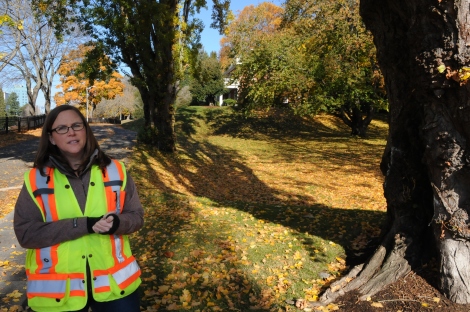
Amanda Bennett, Naval Facilities Engineering Command Northwest, Cultural Resources Specialist, explains the process by which 100-year-old Lombardy poplars will be replaced. The replacement trees are drought resistant, long-lived and disease resistant varieties.
SILVERDALE, Wash. – A Navy project to evaluate, remove and replace historic trees in significant decline at Naval Base Kitsap-Bremerton is underway which addresses safety concerns. Nearly 20 trees, some more than 100-years-old, are being swapped with in-kind or similar species.
A certified arborist from Total Landscape Corporation of Seattle performed a tree survey which identified trees in significant decline and posed a safety hazard in 2016. The trees are located within four historic districts listed in 1990 on the National Register of Historic Places. The trees and surrounding landscapes are characteristic features of each district.
The Puget Sound Radio Station Historic District is significant because of the buildings associated with radio communication at the Puget Sound Naval Shipyard from 1894-1941. The Officer’s Row Historic District contains residences built from 1896-1913 to provide housing for shipyard officers. The landscape includes natives, ornamentals, as well as apple, pear and cherry trees.
The adjacent Hospital Reservation Historic District is significant for buildings associated with the Puget Sound Naval Shipyard Navy hospital. The Marine Reservation Historic District residences were constructed from 1911-1914.
Trees in this area include Lombardy poplars, Douglas firs, and other mature ornamental trees. Some of the Lombardy poplars are 80-feet-tall and 10-feet thick at the base.
“These poplars were likely planted soon after the homes were built,” said Terri Jones, Regional Forester, Naval Facilities Engineering Command Northwest (NAVFAC NW). “Just like people, trees don’t live forever. Trees in the historic district are getting old and are periodically monitored with the intent to keep them as long as possible. However, sometimes tree decline becomes significant enough that hazards such as falling large limbs or excessive brittleness present safety concerns that result in the need to remove and replace the tree with another tree appropriate to the historic district.”
The large Lombardy poplars are located adjacent to the sidewalk on NBK-Bremerton at Doyen and Decatur Streets.
“During wind storms, branches have been known to break and fall causing potential hazard to pedestrians,” said Amanda Bennett, Cultural Resources Specialist, NAVFAC NW. “A 3D tomography (Ultrasound used on trees) survey found that some of the trees are hollow with limited rind thickness in places that bring the structural soundness into question. In at least one case, a swarm of bees has taken up residence in the hollow stem.”
“Because the Lombardy poplars have aggressive root systems and tend to have brittle branches, the trees are no longer used to line busy streets,” said Julia Stockton, Biologist, NAVFAC NW. “In place of the poplars, the Navy will plant either the Columnar hornbeam or an appropriate Aspen species. The replacements are drought resistant, long-lived and disease resistant varieties.”
The work was reviewed by the Washington State Historic Preservation Officer at the Department of Archaeology and Historic Preservation. The consultation is required under Section 106 of the National Historic Preservation Act of 1966. The state agreed the tree removal and replacement will have no adverse effect on the historic properties listed on the National Register of Historic Places.
“The change in species will eventually contribute to regaining the visual integrity of the historic district and reduce potential hazards,” concluded Jones.
At the time these trees were taking root in Bremerton:
- The “Zimmermann Telegram” is sent from Germany to Mexico, stating in the event of the U.S. entering World War I on the allied side, Mexico would be given Texas, Arizona and New Mexico. Intercepted by British intelligence and partially deciphered the next day. Its release shifts U.S. public opinion in favor of war against Germany.
- The U.S. declared war on Germany, entering World War I
- The U.S. Congress passed Selective Service Act, authorizing the federal government to raise a national army for the American entry into World War I through compulsory enlistment
- First units of the American Expeditionary Force, commanded by Gen. John J. Pershing, ordered to France
- The British Royal Family, which has had strong German ties since George I, renounces its German names and titles and adopts the name Windsor
- World War I: Battle of Beersheba in southern Palestine – “last successful cavalry charge in history” performed by the 4th Australian Light Horse
- The 18th Amendment of the U.S. Constitution, authorizing prohibition of alcohol, is approved by the U.S. Congress and sent to the states for ratification
- Babe Ruth beats New York Yankees, pitching 3-hit 10-3 win for the Boston Red Sox.
- E. Lawrence joins the forces of the Arabian sheik Feisal al Husayn, beginning his adventures that will lead him to Damascus by October, 1918. Lawrence is known as “Lawrence of Arabia.”
- Loretta Walsh becomes U.S. Navy’s first female Petty Officer
(Posted 11-13-17)
